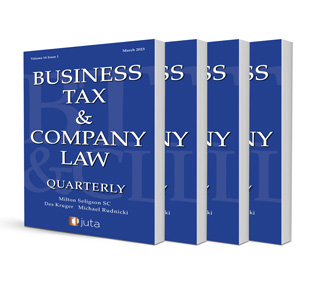
Equity Equivalent Programmes: A Tax Analysis
Author: Michael Rudnicki
ISSN: 2219-1585
Affiliations: Tax Executive, Bowman’s Attorneys
Source: Business Tax & Company Law Quarterly, Volume 16 Issue 3, 2025, p. 23 – 29
Abstract
The concept of ‘Equity Equivalents’ in the context of BEE ownership rules and regulations is rearing its head once more. Foreign organisations seeking investable presence in South Africa are cautious about giving up true equity. Ownership points play a key role in the ‘BEE score card’ table. The Department of Trade, Industry and Competition has historically accepted an alternative basis to transfer equity to black owned small and medium organisations. The alternative is referred to as an ‘Equity Equivalent’ programme.
The programme typically envisages a percentage of turnover over a period of time (typically seven to ten years) to be deployed in qualifying beneficiaries or participants in categories of investment such as supplier development, training and research.
This article considers the tax deductibility of the EE expenditure in terms of section 11(a) of the Income Tax Act (’the Act’).
It is submitted that expenditure is ‘actually incurred’ not at the time of signing the framework agreement with the DTIC, but when the contractual obligation to pay beneficiaries arises.
The ‘in the production of income’ test focuses primarily on the act giving rise to expenditure. In the Warner Lambert case (see below for detail), the court concluded that expenditure incurred in respect of social responsibility obligations meets the ‘in the production of income’ test. It is submitted that BEE related expenditure incurred to retain and grow market share meets this test. So too, it is submitted, does expenditure incurred in respect of the EE programme meet this test. The purpose of concluding this programme is to maximise earnings covering existing and new markets.
The more sensitive issue in respect of EE related expenditure is the capital versus revenue nature of the expense. Generally, expenditure incurred in performing the income-earning operations of a business is revenue in nature. Expenditure incurred as part of the cost of establishing or enhancing or adding to the income-earning structure is capital in nature. Supplementary tests are the ‘once and for all test’ and the ‘enduring benefit’ test.
Warner Lambert, supra, considered the social responsibility expenditure in the context of capital and revenue. It concluded that the taxpayer’s income-earning structure had been erected long ago. The expenditure it incurred was to protect its earnings. Accordingly, the judgment concluded that the expenditure was revenue in nature. In the case of companies having erected their income-earning structure long ago, the EE related expenditure does not create an additional structure. Ownerships points are but one of the elements of the BEE scorecard. But the key feature of the expenditure is to maintain and improve market share, thereby protecting the entity’s earnings. As a result, it is submitted, such expenditure is not of a capital nature. The same conclusion should prevail, it is submitted, where a foreign organisation establishes presence in South Africa for the first time and seeks to maximise its market share. Using this income-earning structure to seek profitable business and as a result incur EE related expenditure, does not, it is submitted, label such expenditure capital in nature.